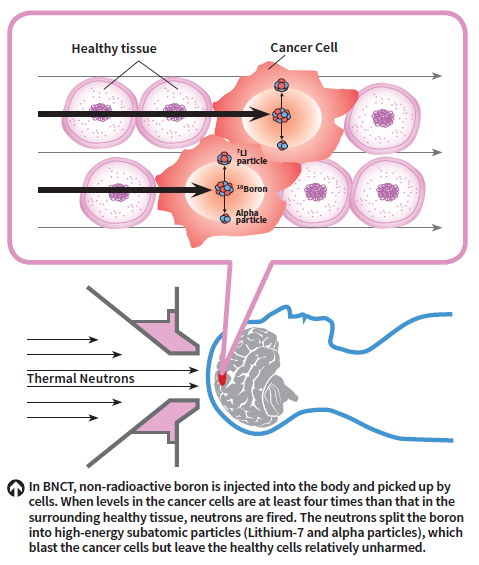New approach in radiation therapy which aim to kill cancer cells but avoid damage to normal cells is being studied at the National Cancer Centre Singapore (NCCS).
Continued from previous page.
Dr Daniel Quah, Associate Consultant,
Department of Radiation Oncology and
Department of Palliative Medicine,
National Cancer Centre Singapore (NCCS), a member of the
SingHealth group shares more on BNCT and the benefits.
HOW BNCT WORKS
In BNCT, Boron-10 (10B), a non-radioactive variant, is injected into the body where it stays for up to two hours. Currently, the amino acid boronophenylalanine is the most common delivery agent for the boron. After the injection, the patient would rest while the body excreted the boron.
Tumour cells hold much more of this 10B than normal cells. BNCT works when there is at least four times more boron in the tumour than the surrounding healthy tissue. When this ratio is reached, neutrons are directed at the tumour, blasting it while leaving healthy cells in surrounding tissue relatively unharmed.
Dr Quah said that researchers are now working on developing other agents to achieve even higher boron concentrations in tumours. Many drug companies are also eyeing this as it means they can now start creating an agent specific to certain tumours.
The keen interest in developing new, more effective agents is not surprising, as the boron carrier accounts for a large chunk of the US$40,000 (about S$53,364) or so price tag for one BNCT treatment.
“What I foresee is that, as the boron carrier gets more and more specific, one will see virtually no toxicity in the future. BNCT gives patients who are unsuitable for surgery and radiotherapy, an option to change the course of their lives.”

ADVANTAGES OF BNCT
- High-energy particles destroy tumour cells with little damage to normal tissue
- Treatment takes one to two hours versus the six to seven weeks needed for current radiotherapy
- As normal tissue receives negligible doses, repeated irradiation can be safely performed
AFTER FUKUSHIMA – ACCELERATORS NOT NUCLEAR REACTORS
Nuclear reactors are the source of neutrons for BNCT. However, countries which do not want to build nuclear reactors do have an alternative: particle accelerators.
Accelerator-based neutron sources, on the other hand, are described as compact, environmentally- friendly, small enough to fit into a room, easily turned off and on, and – at about US$22 million – cheaper than a nuclear reactor.
In recent years, countries have moved towards accelerators, with development intensifying since the Fukushima incident.
Dr Quah said: “They are being built in Japan, Argentina, Russia, Israel and China. Dubai has just placed an order. Once you have an accelerator-based neutron source, anyone anywhere can buy the machine. The advent of these systems will help BNCT become the next big thing in radiotherapy.”
Ref: Q15
